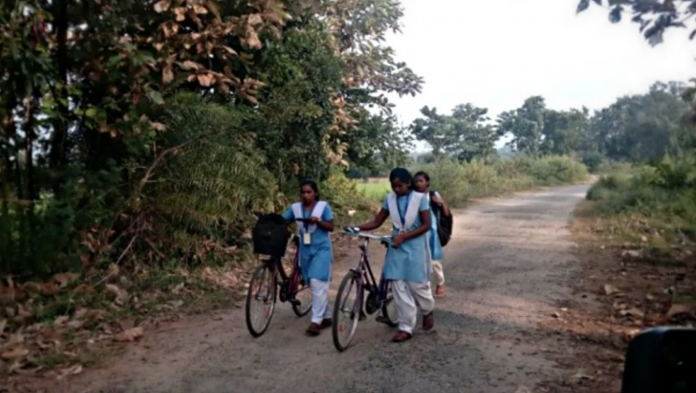After an order by the Patna High Court to address the high drop-out rate of tribal children in the state, the government in Bihar has launched a “special drive” to curtail the drop-out rate of tribal children and increase enrollment.
Sami Ahmad | TwoCircles.net
PATNA (BIHAR) — Bihar government has launched a campaign to address and minimize the high drop-out rate among Adivasi (tribal) children following a recent Patna High Court order on the public interest litigation (PIL) filed by Bihar Adivasi Adhikar (Rights) Forum.
The petition was filed by the rights group on September 9, 2020, and 14 orders have been passed in the case so far. The petition, which quotes figures from the Bihar Economic Survey and Education department’s report of 2019, states that “the drop-out rate among Adivasi students of secondary classes is more than 30 percent.”
One petitioner in the case Bhartiye Thaaru Kalyan Mahasangh had put forward the plight of one school Yugal Shah Tribal Girls High School in Harnatand, the district of West Champaran where drop-out rates were the highest.
On September 25, the court observed that the “petitioner has highlighted the apathy and policy paralysis on the part of the Government in fulfilling the Constitutional goal and the fundamental duty of providing education to the children, more specifically girls hailing from the tribal area falling within the hilly areas of district West Champaran.”
The petitioners pointed out in the court that the tribal population in the said district was approximately 2.5 lacs and there was only one girls’ school namely Yugal Shah Tribal Girls High School. It was alleged that a decision was taken to not only reduce the number of students but also close down the hostel facility for the girl students. The petitioners also pointed out that the student ratio was allegedly purposedly allowed to slip “with an oblique motive of shutting down the institution.”
Pramod Kumar Singh, patron of Bihar Adivasi Adhikar Foundation, the main petitioner in the case told TwoCirles.net that the number of enrollments in the said school was declining every year after 2013. He said the hostel was closed in 2019, and only two classes 9 and 10 were allowed to continue while classes 6 to 8 were scrapped.
“The provision of having five teachers per class was also abolished. Only one teacher per class was allowed, which forced the students to drop out of the school,” he said.
Observing on the matter, the high court on November 5, 2020, said, “We only remind ourselves of the Constitutional mandate provided under Part-IV (Article 46) of the Constitution of India. This section tells, “The State shall promote with special care the educational and economic interests of the weaker sections of the people, and, in particular, of the Scheduled Castes and the Scheduled Tribes, and shall protect them from social injustice and all forms of exploitation.”
Again on October 11 same year, the high court observed that there are two areas of great concern. “One is the non-utilization of funds allocated by the Central Government, as has been evident from the chart indicated in paragraph no. 8 (pages 10 and 11 of the affidavit) and second is the high level of drop-out rate of children more so at the level of middle and secondary level.”
A letter dated October 21, 2022, by Director (Secondary Education) Manoj Kumar addressed to all the District Education Officers of Bihar states that the high court has ordered to minimize the drop-out among the children of the tribal community at the primary and secondary level.
This letter urges the district education officers to bring the drop-out rate to zero by conducting special drives. It calls for ensuring 100 per cent admission of the dropped-out students by covering the beneficiary schemes like scholarship, uniform, cycle and girl adolescent health schemes by November 10. The next hearing is scheduled on November 14. The letter requests the DEOs to give this drive a top priority.
Pramod Singh said that government officials are expected to fulfil their promise to reduce the drop-out rates among tribals seriously. According to him, there are 4,23,568 households of tribals in Bihar, and each family consists of an average of 5.3 members. “The population of tribals in Bihar is estimated to be more than 23 lakhs though according to the census of 2011, the number is said to be just above 13 lakhs,” Singh said while calling it a “population scam.”
President of Bihar Adivasi Adhikar Forum, Nishikant Mandal told TwoCircles.net that they have been fighting for the rights of the tribal community since 2002. “Our main concern is the low education among the tribal population.”
Mandal hoped that with the government’s campaign to increase the number of admissions and curtail the drop-out rate, the number of tribal children going to school and availing education will increase.
“Till now, we have not seen the groundwork in this regard. We are waiting for the next hearing and what the government officials say in the court,” he added.
Sami Ahmad is a journalist based in Patna, Bihar. He tweets @samipkb


